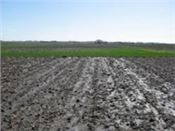|
New Models Better Predict Field Working Days

URBANA, ILL.
• Farmers and risk managers rely on accurate predictions of soil workability to plan field working days, but weather variability is making predictions less reliable.
• New models, developed by University of Illinois researchers, provide a way for farmers and risk managers to make more accurate predictions of field working days.
• The models improve field working day estimates from early spring through mid-summer, encompassing a wide variety of field operations, including soil preparation, planting and pest management applications.
Farmers and crop insurers depend on seasonal predictions of weather and soil workability to select appropriate cultivars, make decisions about planting and harvest dates, forecast yield, and determine risk. However, climate change-induced weather variability is making it harder to predict workable conditions for crop production systems. University of Illinois researchers developed new models that improve the ability to forecast field working days, even under changing climatic conditions.
“On any given day, a farmer is going to know very precisely whether the soil is going to be workable,” says U of I ecologist Adam Davis. “What we’re trying to do is take that ‘farmer sense’ and convert it into something measurable and predictable.”
Field working day prediction models are primarily useful in risk assessment.
“These models examine the relationship between management timing and factors such as changing climate, machinery selection, or simply year-to-year weather variability. An unbiased model is required to appropriately quantify these risks.”
One of the models, which was based on 52 years of Illinois soil moisture data and weekly field working day data, eliminated systematic prediction biases at the state level and significantly reduced them at the crop reporting district level. This model could be applied to regions outside Illinois, since USDA working day reports are available for most other states.
The errors that existed in earlier field working day predictions occurred most frequently in April and May, an interval that previous predictions suggested would be favorable for planting. In recent years, however, April and May have been substantially wetter compared with the 30-year average.
“Going forward, if there are going to be more really wet days in mid-April through mid-May, that’s going to greatly reduce the chances of timely corn planting. If you reduce the chance of timely planting, you’re suddenly looking at more of an overlap between the anthesis-silking interval of corn and drought periods in the summer,” Davis notes.
Climate models predict warmer, wetter springs and drier, hotter summers. Since publishing this study, the team has integrated future climate scenarios like these into their field working day models. This will eventually allow them to make more specific recommendations to Illinois farmers, extension specialists, and risk managers.
“Optimization of agricultural field workability predictions for improved risk management,” appears in Biometry, Modeling, and Statistics. Lead author Bradley Tomasek is now in a Ph.D. program at Duke University. Co-authors Marty Williams and Adam Davis are Research Ecologists with the USDA Agricultural Research Service, and faculty members in the UIUC Crop Sciences Department. Funding was provided by the USDA Agricultural Research Service.
The article is available online at https://dl.sciencesocieties.org/publications/aj/abstracts/107/2/627. ∆
|
|